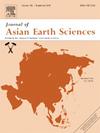Petrogenesis of Mesoproterozoic kimberlites in the Chigicherla region, Eastern Dharwar craton, Southern India: Insights into the origin of small-volume, enriched-mantle derived melts and link to subduction and supercontinent cycle
IF 2.7
3区 地球科学
Q2 GEOSCIENCES, MULTIDISCIPLINARY
引用次数: 0
Abstract
We present new mineralogical, elemental and U-Pb perovskite age data for diamondiferous intrusions from Chigicherla kimberlite cluster of the Eastern Dharwar craton (EDC) in southern India. These rocks display inequigranular textures and contain macrocrysts, and segregations of solidified melts which are interpreted to be magmaclasts. Mineralogical studies indicate that intrusions CC-1 and CC-2 show a similarity to Kaapvaal lamproites, while the other three intrusions (CC-3, CC-4, and CC-5) display characteristics indicative of true kimberlite nature. The whole rock major and trace element geochemistry, involving large-ion lithophile and high-field strength elements, supports this observation. The geochemical signatures resembling Ocean Island Basalts (OIB) and metasomatism of source regions by fluids/melts emanating from deep-sourced upwelling mantle are consistent across the Chigicherla intrusions, mirroring other kimberlite intrusions within the EDC. Perovskite dating revealed a 206Pb/238U age of 1110 ± 9.5 Ma for the CC-1 pipe and 1116 ± 14 Ma for the CC-3 pipe.
This new data enables us to study the genesis of the Chigicherla intrusions specifically and to propose a new geodynamic model for the eruption of kimberlites and lamproites in southern India in general. The eruptions of predominantly kimberlites between 1055 and 1153 Ma and lamproites between 1300 and 1400 Ma are attributed to processes such as prolonged subduction, lithospheric extension, and mantle return flow, considering the plate tectonic evolution of the EDC during the Mesoproterozoic.
印度南部Dharwar克拉通东部Chigicherla地区中元古代金伯利岩的岩石成因:小体积富地幔熔融体的成因及其与俯冲和超大陆旋回的联系
本文报道了印度南部东Dharwar克拉通(EDC) Chigicherla金伯利岩群含金刚石侵入体的新的矿物学、元素和U-Pb钙钛矿年龄数据。这些岩石呈非等粒结构,含有大结晶和分离的凝固熔体,被解释为岩浆岩。矿物学研究表明,侵入体CC-1和CC-2具有与Kaapvaal煌斑岩相似的特征,其余3块侵入体CC-3、CC-4和CC-5具有真正的金伯利岩特征。整个岩石的主要元素和微量元素地球化学特征,包括大离子亲石元素和高场强元素,支持了这一观察结果。类似洋岛玄武岩(OIB)的地球化学特征和源区深部上升流地幔流体/熔体的交代作用在整个Chigicherla侵入体中是一致的,反映了EDC内其他金伯利岩侵入体。钙钛矿测年结果显示,CC-1和CC-3的206Pb/238U年龄分别为1110±9.5 Ma和1116±14 Ma。这些新数据使我们能够具体地研究奇切拉侵入岩的成因,并为印度南部的金伯利岩和煌斑岩的喷发提出了一个新的地球动力学模型。1055 ~ 1153 Ma期间的金伯利岩为主,1300 ~ 1400 Ma期间的煌斑岩为主,考虑到中元古代EDC的板块构造演化,认为其喷发主要是由于长时间俯冲、岩石圈伸展和地幔回流等作用。
本文章由计算机程序翻译,如有差异,请以英文原文为准。
求助全文
约1分钟内获得全文
求助全文
来源期刊

Journal of Asian Earth Sciences
地学-地球科学综合
CiteScore
5.90
自引率
10.00%
发文量
324
审稿时长
71 days
期刊介绍:
Journal of Asian Earth Sciences has an open access mirror journal Journal of Asian Earth Sciences: X, sharing the same aims and scope, editorial team, submission system and rigorous peer review.
The Journal of Asian Earth Sciences is an international interdisciplinary journal devoted to all aspects of research related to the solid Earth Sciences of Asia. The Journal publishes high quality, peer-reviewed scientific papers on the regional geology, tectonics, geochemistry and geophysics of Asia. It will be devoted primarily to research papers but short communications relating to new developments of broad interest, reviews and book reviews will also be included. Papers must have international appeal and should present work of more than local significance.
The scope includes deep processes of the Asian continent and its adjacent oceans; seismology and earthquakes; orogeny, magmatism, metamorphism and volcanism; growth, deformation and destruction of the Asian crust; crust-mantle interaction; evolution of life (early life, biostratigraphy, biogeography and mass-extinction); fluids, fluxes and reservoirs of mineral and energy resources; surface processes (weathering, erosion, transport and deposition of sediments) and resulting geomorphology; and the response of the Earth to global climate change as viewed within the Asian continent and surrounding oceans.
 求助内容:
求助内容: 应助结果提醒方式:
应助结果提醒方式:


